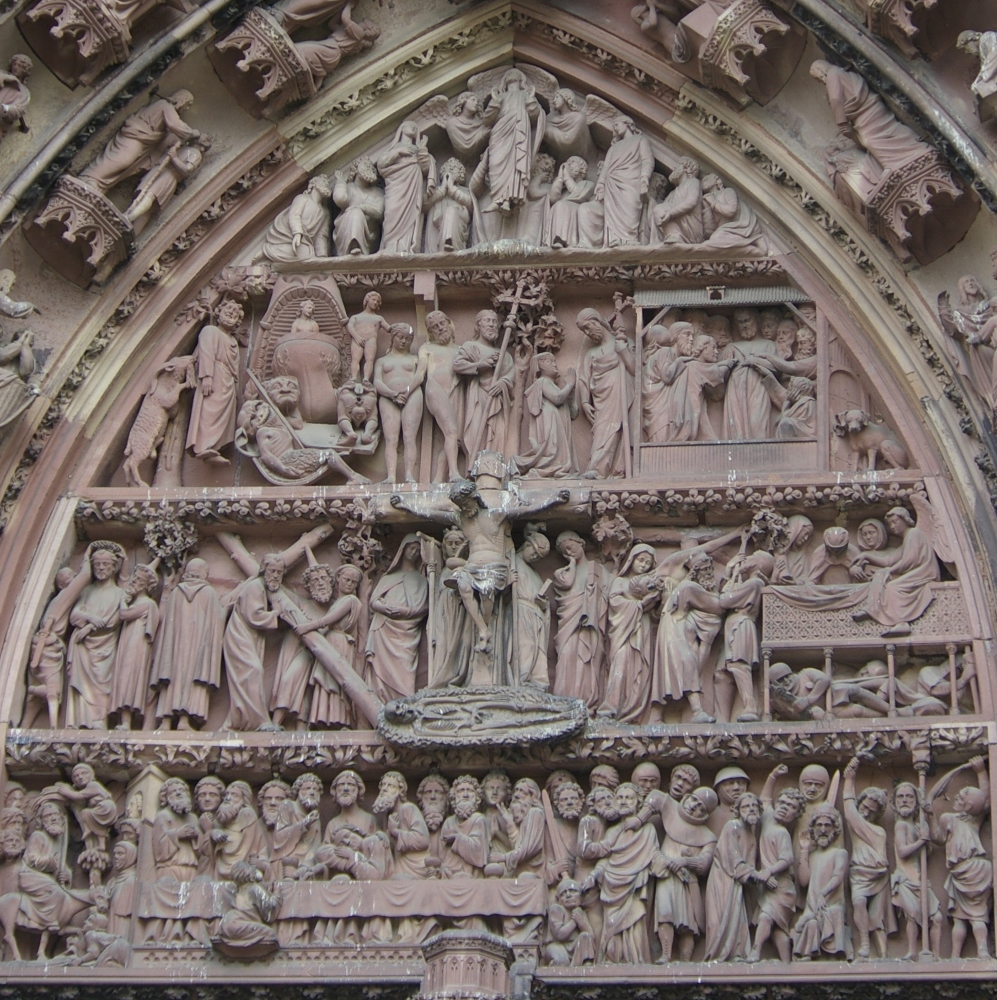
Tuesday 28th May
4:00pm Reception at St Thomas’s Church
(The Friary) (Includes Evening Prayer from the Office of the Dead)
Wednesday 29th May
11:00am Requiem Mass
We expect the Mass to be livestreamed: https://www.stthomaswoodford.org/watch-mass-live
May our brother Austin rest in peace and rise in glory! AMEN.
+++++++++++++++++
Here is a reflection of Austin’s for Eastertide, illustrated by these carvings at Strasbourg Cathedral, showing the events of Holy Week with the Crucified at the centre, full of vigour as he stares death out. Above, the Risen Lord leads his first parents into Paradise, above that again the Ascension.
We have received the link to this Easter reflection by our old friend, Brother Austin, a link we gladly share.
Jesus understood his mission to be, to make his Father known; not by talking about him, but by being himself with other people, his Father’s Son – and that still remains the mission of the Church – go out and spread the Good News – what it means to be beloved of Abba, share your experience, not your knowledge, of who Jesus, the beloved of Abba, is for you.
At this time there were no defined doctrines, creeds or codes – so what were they expected to do when they were told to go out and spread the Good News? Was it to teach and preach? It was something much simpler and much more profound – they were asked to go and share what it was like to live with Jesus, after the Resurrection – share their experiences of being with him.
The Resurrection brought new insights – something Jesus had before his Passion and death; when he told them you do not understand now but you will… He spoke of God in an entirely new way, one which proved threatening to the Guardians of the Law, to Temple worship, Sabbath observances and ritual prescriptions. The last straw was calling God his father. The disciples after Good Friday, must have thought, maybe the authorities were right after all, that Jesus was not from God. Death was final, and put an end to dissent.
Two of them were walking to Emmaus with hopes shattered [we had hoped]. His death seemed to vindicate that Jesus must have been a sinner for this to happen –he who hangs on a tree is cursed – Deuteronomy 21.23; Galatians 3.13. But when he rose from the dead and appeared to them the whole system leading to his death is called into question. Jesus had been right; God is the way Jesus spoke of God; nothing like the description of his accusers. The reasons for getting rid of him were part of the sinful mechanism of getting rid of troublesome people – with nothing whatever to do with God. This leads to questioning the Law as not reflecting the true God. The Resurrection did not simply reveal Jesus’ innocence, not only was he right about God; it exposed the mechanism by which innocent victims are created by those who believe that in doing so they are doing God’s will.
It is true that the Law was given by God – but the interpretations of it are of human origin; and so, for example, keeping the Sabbath holy, came to mean observing all the restrictions imposed – not by God. The point of Sabbath is so as to enjoy the wonderful things God is doing through creation.
We can now imagine the innocence of the victim and see the complicity in violence of the perpetrators. If we see things as the disciples first did, feeling uncomfortable that Jesus may not have been up to what he promised – and then see him back, how would we talk about it? Our stories have beginnings and endings, and, so they had thought, did Jesus’ story – but now: how do we tell a story that has no ending? They tried telling this story which had no room for death – death happens to everyone – and they didn’t know how to do it.
Resurrection has now burst into our storytelling. They couldn’t tell the story in the old way, the new way they were inspired with we call the New Testament. It was not a question of eliminating death, but showing how death has its part in the story, but not as the ending. Jesus did not appear as someone who had been dead and is now better – like Lazarus. The risen Jesus is simultaneously dead and alive – as the five wounds testify – death as lost its power. He is at once dead and alive. His whole life, including death is present in its fullness. He has conquered death, not just for himself, but for all who share common humanity with him; death and its whole system by which all were held in fear, is not necessary. Whatever death is, and it happens to all of us, it is not what dictates or shapes the pattern of life. It is an empty shell, a bark without a bite. We will die, but death cannot separate us from the source of the fullness of life.
Because each one of us is unique [God doesn’t create copies], every sharing will reflect what is ours only, and wouldn’t happen without us – differences [not division] unity without uniformity – which we are able to do by sharing in his Spirit freely given in our Baptism.
AMC
